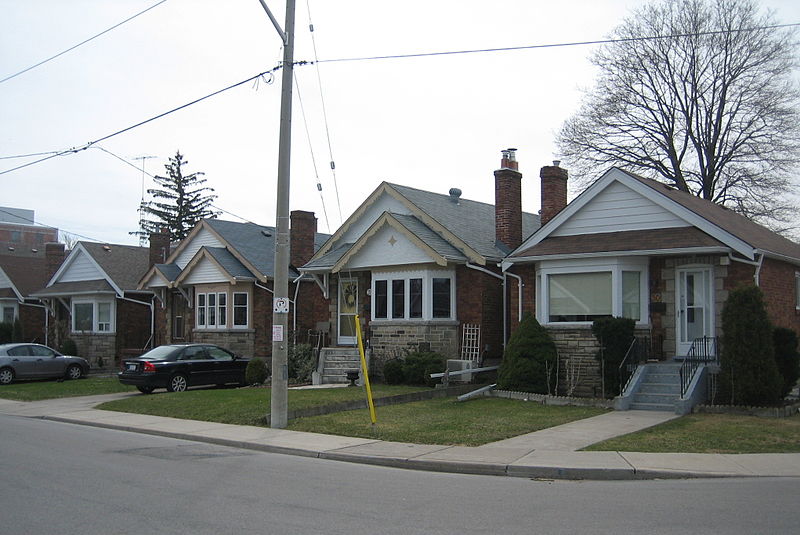Quite a few prominent architects designed small houses for CMHC over the years. No matter how determinedly some may wish to distance themselves from design excellence it may have affected their lives at some point or other.
Sometimes you get what you need
The 'small houses' promoted by the CMHC in the postwar years, and built by thousands of Canadians, offered an example of graceful living within one's means. Maybe, in a time of economic crisis, it's time to appreciate them anew
By Maria Cook,
The Ottawa Citizen March 21 2009
In 1959, newlyweds John and Barbara Walsh built a riverfront house in Manotick using architect-designed plans they bought from the Central Mortgage and Housing Corporation for $10.
"It was a lovely home," recalls Mrs. Walsh, 78. "It was really well-planned. It didn't feel small."
They were among thousands of Canadians who bought blueprints for small house designs from the federal agency, now called Canada Mortgage and Housing Corporation (CMHC).
Did you build, design or grow up in one of these houses? If so, Ioana Teodorescu would love to hear from you. She is a doctoral candidate at McGill University who lives in Ottawa and is researching the CMHC small house program.
The CMHC published catalogues of designs by Canadian architects from 1947 to 1974. It sold the plans cheaply in an effort to address the postwar housing shortage and improve standards.
"A lot of Canadians live in them," says Ms. Teodorescu. "Canadians were pretty down-to-earth people in those days. They bought as much as they could afford and expanded later if they could afford it. These designs offered the flexibility to do so."
In a time of global recession triggered by the United States housing market crash, Ms. Teodorescu says the designs offer an example of graceful living within one's means.
"Especially in times of crisis, you should buy a home that meets your needs rather than your wants," agrees Bill Teron, head of CMHC from 1974 to 1979.
"We've got to go back to adequacy and affordability," Mr. Teron says. "In this economic climate what we're being penalized for is waste and decadence."
He says he has been in talks with CMHC and the Conference Board of Canada about the federal government stimulus package. He believes the government should have programs that promote smaller, affordable and well-designed housing.
The CMHC would do well to resurrect the catalogues and add new designs, he adds. "It was a marvellous service, particularly for smaller communities."
Today, because of the high cost of living in Ottawa, people are moving to outlying towns such as Kemptville and Carleton Place, he says. "People have to go to the fringe. That's where they can build."
The CMHC designs featured stand-alone houses -- bungalows, split-level and two-storey. The average three-bedroom was about 1,000 square feet (compared to at least twice that size today). They were modern, simple and functional and ranged in cost from about $10,000 to $22,000.
One of the most popular plans was Design 231, which sold 6,177 copies between 1963 and 1974. It was for a 1,031-square-foot, three-bedroom bungalow.
"The combined living and dining room with windows looking both to the garden and the street make each of these well-defined rooms appear to be bigger than they are," said the catalogue blurb.
"It was quite compact, clear and easy to build," says Ms. Teodorescu.
Buyers received four copies of working drawings for $10 plus tax. Extra copies were available for $2.50 plus tax.
Mr. Teron guesses that some of the houses were built in areas that were then on the outskirts of Ottawa, such as Bells Corners, Westboro, Britannia, Blossom Park, and around Baseline Road and Woodroffe Avenue.
The Walshes chose Design 274 from the Small House Designs catalogue published in 1958. The architect was Andrew Chomick of Vancouver. They paid $3,000 for a lot ("all the money we had," says Mrs. Walsh) and took a CMHC mortgage to build the $18,000 house. At that time, banks would not lend for a house in the country.
The Walsh house was a bungalow with a carport. It had cathedral ceilings and an open plan. The living room featured a glass wall on the river side and a deck. The three bedrooms were located in a private wing.
Changes to the design needed CMHC approval. Mr. Walsh, 80, recalls sticking pieces of paper on the plans to indicate a change. It was late. He was tired. One of his notations read "laundry shoot," he recalls with a smile.
In 1967, they moved to Ottawa. They had two boys by then and the Manotick school was too far. They kept the house until 1987 as a summer home and rental property, imagining they might return one day.
The catalogues reflect an evolution in Canadian living standards, says Ms. Teodorescu. The late 1940s designs were for minimal houses; a living room, a kitchen, two bedrooms and a bathroom. The attic was usually advertised as a zone for potential expansion.
By the late 1950s the three-bedroom house became the popular choice. Powder rooms were added and family rooms near the kitchen begin to appear. The carport was typical in the 1950s, before garages came on the scene in the 1960s.
CMHC paid architects for their designs and gave them royalties from sales.
A number of Ottawa architects contributed, including Michael Dixon -- who designed much of Manor Park -- Sam Gitterman and Paul Schoeler. Well-known architects who took part included Ray Affleck of Montreal, Henry Fliess of Toronto and Gustavo DaRoza of Winnipeg.
"Almost every firm in Canada designing homes produced at least one small house design for the CMHC," says Parks Canada architectural historian Andrew Waldron.
"Many of the plans were altered to fit the home builder's requirements. They were more common in smaller cities and rural towns because there were no major developers building houses in these places."
Avi Friedman, director of the affordable homes program at the McGill University school of architecture, says that economic and demographic trends will drive interest in smaller houses.
"What commonly happens during bad times is there is a rise in interest in affordable housing," Mr. Friedman says. "People psychologically are reluctant to commit themselves to large mortgages.
"The retirement of the baby boom generation, the trend to have less children, the divorce rate and postponing ages of marriage and having kids means that some of these people will search for a smaller home."
The rising cost of fuel and energy is another factor, he says.
"Small houses are known to consume less energy."
He predicts an interest in "micro-lots" or very small lots. "We've seen this already in B.C."
Should the CMHC decide to repeat the small house program, energy efficiency and sustainable design should play a big role, he says.
A spokeswoman for CMHC says there are no plans to bring back the small house program.
However, the agency provides online information on how to choose housing that is in keeping with lifestyle and finances.






